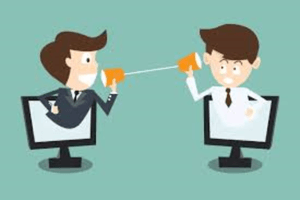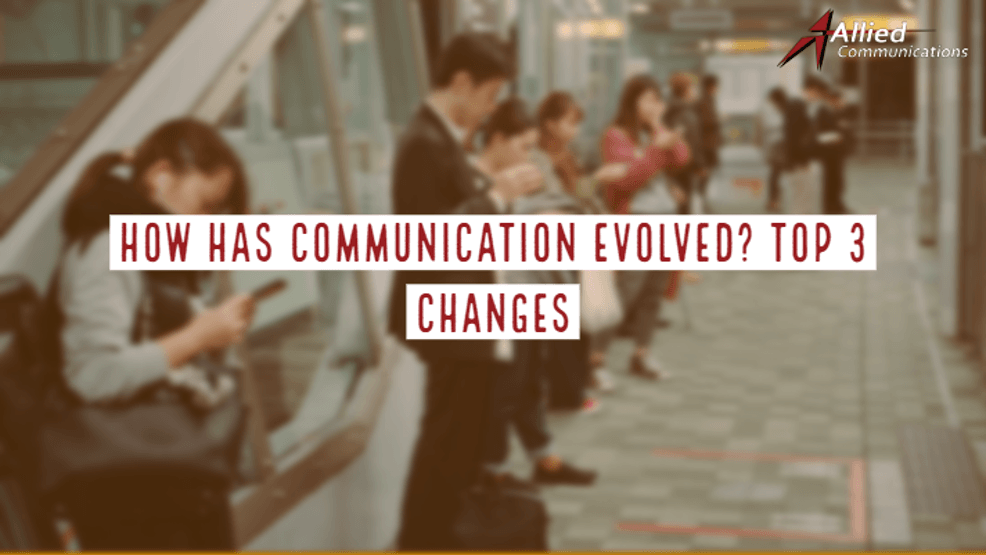A Long Time Ago
Communication in the workplace is an art form that has endured many changes over the course of time. From water cooler chat to the invention of the email, the way in which we communicate has improved and evolved completely. Pre-internet days meant three ways to speak to a co-worker or potential client. It had to be done in person, by sending a letter or to pick up the phone.
 These methods are still in existence today. However, they have been altered drastically and some people may even consider these forms to be a nuisance. Phone calls especially have become an annoyance for Millennials and employees of other generations. The medium has changed, but the messaging remains the same.
These methods are still in existence today. However, they have been altered drastically and some people may even consider these forms to be a nuisance. Phone calls especially have become an annoyance for Millennials and employees of other generations. The medium has changed, but the messaging remains the same.
Let’s take a look at 3 major areas of change in business communication and the impact that they’ve had on the workforce.
In-Office Communication
Maximizing the productivity and efficiency of employees is a top priority at most companies. Getting up to walk around and ask questions often lead to a lot of lost time in the workday. Aside from that, it was an inefficient way to communicate that took you away from your desk and the tasks at hand.
Fast-forward to the present day, walking around the office to ask simple questions can be considered your last option. Employees now rely on traditional ways of sending messages, such as email. A quick email being sent to a co-worker in the vicinity is far from uncommon and may be more convenient for everyone involved.
Not only can the message and any contents be archived for future reference, but it also allows for quicker conversations. A question can be answered, and a problem can be solved within seconds. They have their downfall, of course. The amount of emails that people receive on a daily basis can be overwhelming to say the least. Messages can get lost in spam/junk folders, missed completely or misinterpreted.
UCaaS solutions have enabled calls  and voicemails from your office phone to be sent directly to your mobile device. Long-gone are the days where important calls are missed, and information gets lost. Offices and employees have become much more efficient as a result.
and voicemails from your office phone to be sent directly to your mobile device. Long-gone are the days where important calls are missed, and information gets lost. Offices and employees have become much more efficient as a result.
Speaking of efficiency, internal chat apps for employees, such as: Zoom, Slack, and Microsoft Teams allow for conversation to occur in real time. Not only can you communicate with all of your co-workers in one centralized location, you can also organize tasks. These tasks are then assigned to individuals or groups who can keep track of their projects and submit updates.
Outside of Office Communication
Speaking to prospects and current customers has drastically changed for the better. Social media alone has provided a way to speak with and connect with customers on a much more personal level than traditional methods of customer relationship management (CRM).
Customers are able to engage with companies and their employees in a way that helps build and maintain a relationship that may have taken much longer to form. They are able to consume content and interact with the company page at their leisure on their computers or mobile devices. With the current fast pace of our society, especially in the northeastern region of the U.S., this has become the norm.
 Communication has evolved. In the sense that while the language and the content of the message remains the same, the devices and timing of the messages have changed completely. The constant on-the-go mindset of the modern business professional forces companies to shift their marketing efforts to accommodate the current state.
Communication has evolved. In the sense that while the language and the content of the message remains the same, the devices and timing of the messages have changed completely. The constant on-the-go mindset of the modern business professional forces companies to shift their marketing efforts to accommodate the current state.
Text messaging through SMS/MMS has become a popular means of reaching customers to capture their attention in a way that has a lasting impression. In fact, the open rate of SMS text messaging was five times higher than email campaigns (90% Vs. 20%) in 2018. Companies are now able to reach consumers with a higher success rate while improving the cost efficiency of their efforts.
Communicate for Less
The average cost for traditional means of communication have been drastically reduced. Long-distance calling used to be a dreadful process. The consumer watching every minute of the phone call while clutching their checkbook. Fast-forward to 2020 and phone calls are occurring out of state and across the continental U.S. for no additional cost.
Snail-mail at the same distance used to be an expensive package that you would hope would arrive in time to maintain its relevance. Now an email and/or DM on social media can deliver the same message and collateral at no cost to the sender.
A Whole New World
Human communication will always remain the same.  With technology, the only thing that remains constant is change. The preferences and lifestyles of employees and consumers change with the years and companies must either adapt or fail.
With technology, the only thing that remains constant is change. The preferences and lifestyles of employees and consumers change with the years and companies must either adapt or fail.
The methods of communication within the workplace have allowed for increased efficiency while improving the quality of team collaboration. Messages are delivered quickly in real time. Meetings can take place from anywhere in the building or the world. Face-to-face interactions still occur on a daily basis, technology has simply enhanced and supported them.
From the consumer’s standpoint, the fast-paced lifestyle that everyone is now accustomed to resulted in a massive shift in marketing efforts and customer support. Text messages, emails, webinars, live chat bots, etc. are now required to truly connect with consumers in real time.
Failing to adopt new technology is essentially ignoring your customer. The general public has spoken, it’s now your time to utilize the communication tools to build and maintain a lasting relationships and deliver the value they deserve.
We Can Help
For more information about Unified Communications, VoIP or any other product/service offerings, contact Allied Communications, LLC today to learn more about the technology of tomorrow, today.
203.937.0363
www.alliedphone.com


Recent Comments